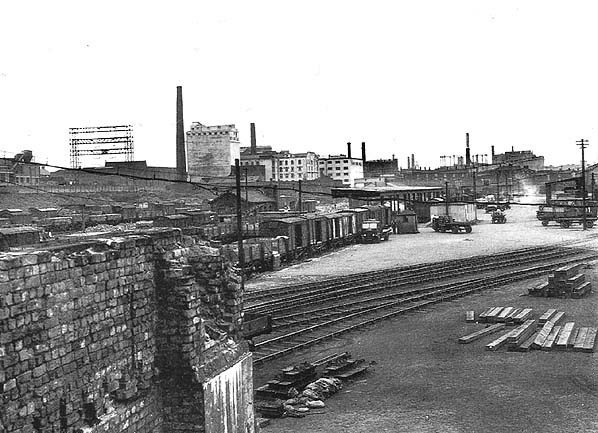
Looking south at the eastern side of Huskisson goods station on 15 July 1952.
Huskisson goods station was situated at the southern end of the Cheshire Lines Railway (CLC) North Liverpool Extension Line, Huskisson Branch. The North Liverpool Extension Line branched of the CLC Liverpool and Manchester line at Halewood and ran to Aintree via Gateacre, Knotty Ash and West Derby. The Huskisson Branch had two junctions with the main line, forming a triangle, to the east of Walton-on-the-Hill: these were Fazakerley South Junction (used by Huskisson branch trains running to and from the Halewood direction) and Fazakerley North Junction (used by Huskisson branch trains running to and from the Aintree direction). The branch forked for the two junctions at Fazakerley West Junction.
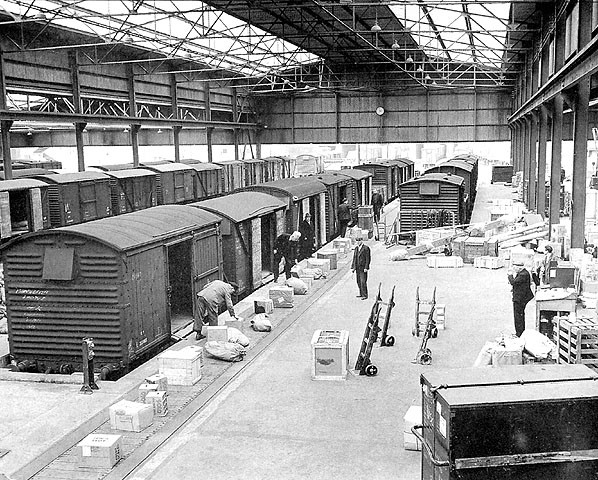
Looking north from the inside of Huskisson goods station in the 1950s.
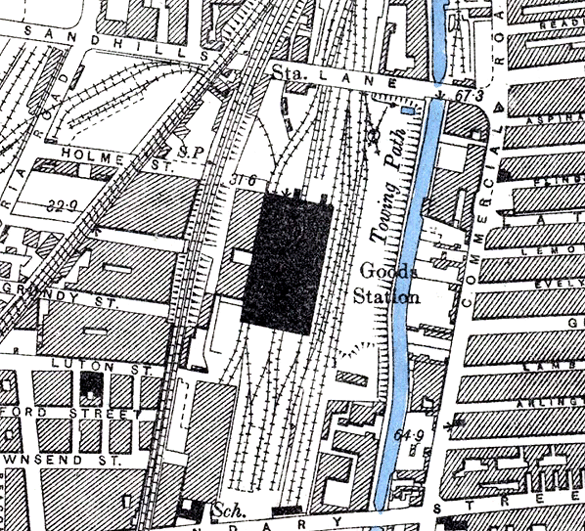 Huskisson goods station shown on a six-inch scale map from 1890.
Huskisson goods station shown on a six-inch scale map from 1890. |
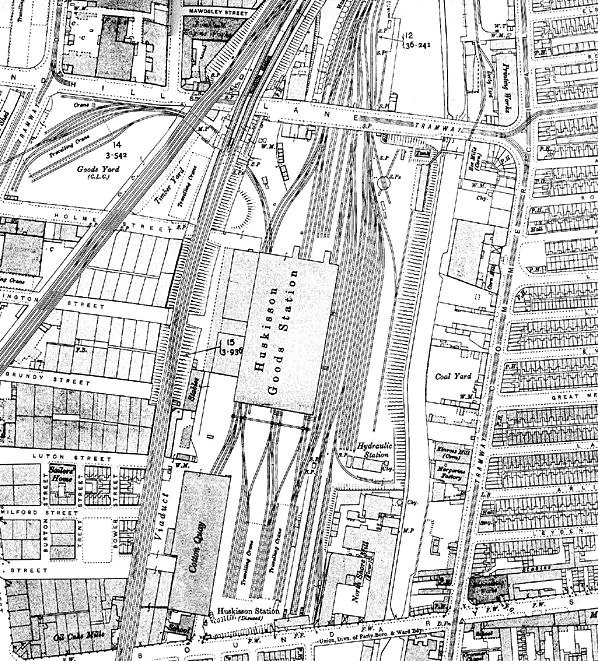
Huskisson Goods Station shown on a 1908 map.
The CLC was a joint railway with three partners, the Great Northern Railway (GNR), the Manchester Sheffield & Lincolnshire Railway (MS&LR) and the Midland Railway (MR). All had wanted access to Liverpool which, by the mid nineteenth century, had become a major seaport. The CLC Liverpool and Manchester line, which opened throughout on 2 September 1873, had given the three companies access to Liverpool, but only to the south docks. To north of the city new docks had been built to accommodate much larger vessels. The London North Western Railway (LNWR) and the Lancashire & Yorkshire Railway (LYR) had access to the north docks, and the CLC partners wanted the same. The most logical way for the CLC to gain such access would have been to extend their Liverpool and Manchester line by three miles from its Liverpool terminus. However this would have involved prohibitively expensive tunnelling under the city centre. The alternative solution was to build a line around the eastern edge of the city using agricultural land that was, by the 1870s, very cheap. The only significant engineering required was at Walton, north of Liverpool. The North Liverpool Extension Line and its branch to Huskisson were authorised on 30 July 1874 and opened from Halewood to Walton-on-the-Hill on 1 December 1879.
The most significant engineering feature on the CLC north Liverpool lines were three tunnels between Walton-on-the-Hill and Huskisson. They were not ready for use until 1 July 1880 when goods services started to operate to and from Huskisson.
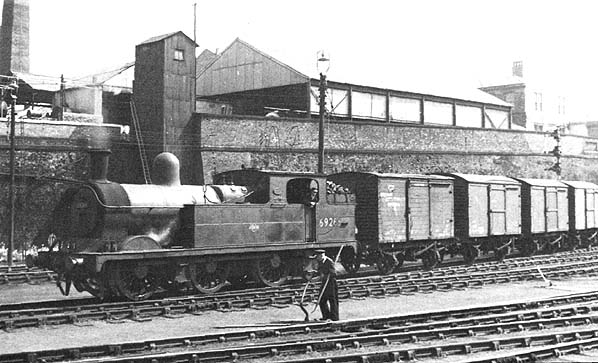
The north end of Huskisson goods station on 3 August 1957. An N5 class locomotive number 69265 is engaged on shunting duties. The locomotive was withdrawn from service a few months later.
Photo by J Peden
The Huskisson goods depot site was half-a-mile long and 450ft at its widest point. Along its western boundary ran the LYR main line from East Lancashire into Liverpool Exchange, and the Leeds & Liverpool Canal bounded it to the east. At the north end of the goods station Sandhills Lane passed over the line on a bridge. The goods station continued north of Sandhills Lane but it was narrowing by that point. Cattle facilities were located on the north side of Sandhills Lane, west of the line. Beyond Sandhills Lane the line went into a short tunnel which passed beneath the Leeds & Liverpool Canal. At the south end of the goods station was Boundary Street. The docks themselves were to the west of the LYR line. A branch of 45 chains ran from Huskisson to the MR Sandon & Canada Dock Goods station via a short tunnel under the LYR line; from Sandon & Canada Dock Goods there was a connection directly to the docks. To reach Sandon & Canada Dock Goods the line crossed Derby Road on the level. Between Derby Road and the LYR line there was a small CLC yard called Victoria Sidings.
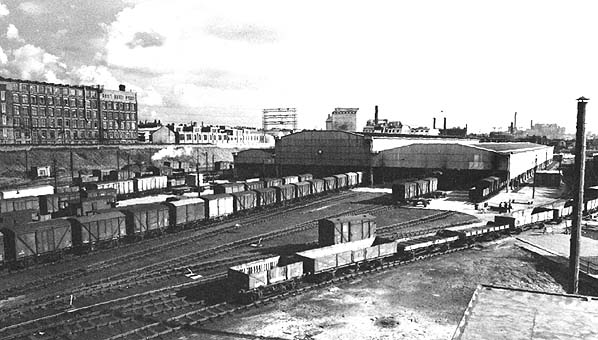
Looking south at Huskisson goods station on 18 July 1960. The station was still very busy at this time.
Photo from the British Railways collection
Standing centrally on the site was a large rail-served covered shed surrounded by numerous sidings. At the north end of the yard a signal box controlled movements into and out of the station. The CLC spent over £150,000 equipping Huskisson with sheds, hydraulic cranes, wharves, offices and a turntable.
Trains were operated by all of the CLC partners, travelling to all parts of Great Britain. Motive power for the trains and shunting engines for the yard were provided by Walton-on-the-Hill shed, a mile north of the goods station. On 1 August 1897 the MS&LR changed its name to the Great Central Railway (GCR). In the last years of the nineteenth century the MR alone was operating goods trains from Huskisson to Carlisle, Stourton, Sheffield, Washwood Heath, Nottingham and Rowsley.
On 14 December 1902 a new Huskisson Goods signal box opened. The old box was closed and demolished. The new box was a CLC type CL1a with a 52-lever frame.
During the Great War the westward-facing Liverpool docks played a major role in trans-Atlantic shipping. All of the goods stations that served the docks were extremely busy, and Huskisson was no exception.
At the grouping of 1923 the CLC remained independent but its parent companies changed. The GCR and the GNR became part of the London & North Eastern Railway (LNER) and the MR became part of the London Midland & Scottish Railway (LMS). The LNER was given two-thirds of the CLC shares and the LMS one-third.
During the Second World War the CLC line from Huskisson was of national strategic importance as it provided a link between Britain’s western gateway (Liverpool Docks) and the rest of the Country. Huskisson was extremely busy freight trains running day and night almost in convoy. The difference this time was that Huskisson found itself in the direct line of fire. It was extensively damaged many times during the period December 1940 to July 1941. The main goods shed was so badly damaged during this period that it had to be demolished.
After the war a new concrete goods shed was built and many modern features introduced including conveyor belts within the shed that were used to move cargo quickly.
On 1 January 1948 the CLC became part of British Railways London Midland Region. Huskisson continued to be a busy goods station in the 1950s. Daily long-distance trains ran to Dewsnap, Mottram, Newcastle and York. By the early 1960s competition from road transport was beginning to have an effect. Walton-on-the-Hill shed was closed on 15 December 1963, and Aintree was given the responsibility for the provision of motive power to Huskisson. Decline was rapid after the closure of Walton-on-the-Hill shed. The line between Huskisson and Fazakerley West Junction was singled with effect from 26 June 1966. The Huskisson Goods signal box closed on the same day. By the late 1960s Huskisson was being served by trip workings from Liverpool Edge Hill that had the train reporting number 9T21. There were supposed to be two trains to and from Huskisson per day but it was rare for there to be more than one.
The last trains ran from Huskisson in July 1975, daily services having ceased in May 1975. The line from Huskisson up to Walton-on-the-Hill was lifted in 1978. The goods station remained open, served by lorries until the early 1980s. It was then demolished and the site cleared.
In February 1994 the Merseyrail signalling centre opened on the northern part of the Huskisson site.
In the late 2000s the site was developed with industrial units.
See also the passenger station: Huskisson
See also: Sandon & Canada Goods Station and Walton on the Hill Engine Shed
Click here to see more photos

